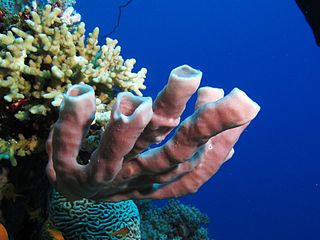Geodia gibberosa, comonly known as the white encrusting sponge, is a species of sea sponge found in the Caribbean. It is eaten by hawksbill turtles. It was first described by Lamarck in 1815.

Geodia is a genus of sea sponge belonging to the family Geodiidae. It is the type genus of its taxonomic family.

Cyanea is a cosmopolitan, or world-wide, genus of stinging jellyfish, primarily found in northern waters of the Atlantic and Pacific Oceans. The same genus name has been given to a genus of plants of the Hawaiian lobelioids, an example of a parahomonym.

Callyspongiidae is a family of sea sponges in the order Haplosclerida. It contains the following genera and species:
Geodia exigua is a species of sponge that produces the sesquiterpene spiro compound exiguamide. The species was first described by Johannes Thiele in 1898. It is a marine organism known from Japan.
Geodia acanthylastra is a sponge species from the family Geodiidae. The species is found in the waters of the Pacific Ocean off the coast of California and was first described by Robert Lendenfeld in 1910.
Geodia composita is a species of sponge in the family Geodiidae. The species was first described by Bösraug in 1913. It is found off the coasts of Mozambique.

Tetractinellida is an order of sea sponges. First described in 1876, this order received a new description in 2012 and replaced the two orders Astrophorida and Spirophorida, which then became sub-orders as Astrophorina and Spirophorina.
Geodia agassizi is a species of sponge in the family Geodiidae. The species is found in the eastern tropical Pacific Ocean and was first described by Robert Lendenfeld in 1910.
Geodia alba is a species of sponge in the family Geodiidae. The species is found in the waters of Indonesia and was first described by Oswald Kieschnick in 1896 as Synops alba.
Geodia hirsuta is a species of sponge in the family Geodiidae. The species is found in the waters of Indonesia and was first described by Sollas in 1886 as Cydonium hirsutum.
Pandea is a genus of hydrozoans of the family Pandeidae.
Geodia angulata is a species of sponge in the family Geodiidae. It is found in the Pacific Ocean off the coast of California.
Geodia macandrewii is a species of sponge in the family Geodiidae. It is found in the waters of the North Atlantic Ocean. The species was first described by James Scott Bowerbank in 1858.
Geodia atlantica is a species of sponge in the family Geodiidae. It is found in the waters of the North Atlantic Ocean.
Geodia bicolor is a species of sponge in the family Geodiidae. It is found in the waters of the Pacific Ocean off the coast of California.
Geodia breviana is a species of sponge in the family Geodiidae. It is found in the waters of the Pacific Ocean off the coast of California. It was first described by Robert J. Lendlmayer von Lendenfeld in 1910.
Geodia carcinophila is a species sponge in the family Geodiidae. The species was first described by Lendenfeld in 1897. It is found in the waters of the Somali Sea around the Zanzibar Archipelago.
Geodia arripiens is a species of sponge in the family Geodiidae. It is found in the waters of the South China Sea. The species was first described by Nils Gustaf Lindgren in 1897.




